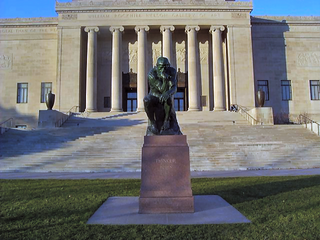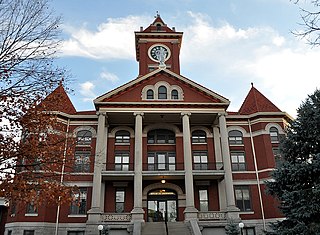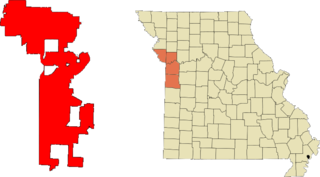
Kansas City, abbreviated as "KCK", is the third-largest city in the U.S. state of Kansas, the county seat of Wyandotte County, and a principal city of the Kansas City metropolitan area. As of the 2020 census, the population of the city was 156,607. The city formed as a streetcar suburb of Kansas City, Missouri, which it borders and after which it is named. It is situated at Kaw Point, the junction of the Missouri and Kansas rivers. It is part of a consolidated city-county government known as the "Unified Government". Wyandotte County also includes the independent cities of Bonner Springs, Edwardsville, a portion of Lake Quivira, and the unincorporated area known as Loring.

Grinter Place is a house on the National Register of Historic Places above the Kansas River in the Muncie neighborhood of Kansas City, Kansas.

The Huron Indian Cemetery in Kansas City, Kansas, also known as Huron Park Cemetery, is now formally known as the Wyandot National Burying Ground. It was established circa 1843, soon after the Wyandot had arrived following removal from Ohio. The tribe settled in the area for years, with many in 1855 accepting allotment of lands in Kansas in severalty. The majority of the Wyandot removed to Oklahoma in 1867, where they maintained tribal institutions and communal property. As a federally recognized tribe, they had legal control over the communal property of Huron Cemetery. For more than 100 years, the property has been a source of controversy between the federally recognized Wyandotte Nation of Oklahoma, which wanted to sell it for redevelopment, and the much smaller, unrecognized Wyandot Nation of Kansas, which wanted to preserve the burying ground.
The Trowbridge Archaeological Site is located in the vicinity of North 61st Street and Leavenworth Road in Kansas City, Kansas. Discovered in 1939 by amateur archaeologist Harry Trowbridge in the back yard of his property, it was inhabited c. AD 200–600 by the Kansas City Hopewell culture.

Wight and Wight, known also as Wight & Wight, was an architecture firm in Kansas City, Missouri consisting of the brothers Thomas Wight and William Wight who designed several landmark buildings in Missouri and Kansas.

This is a list of the National Register of Historic Places listings in Wyandotte County, Kansas.

The Old Greeley County Courthouse in Tribune, Kansas, is the former courthouse of Greeley County, Kansas. Built from 1889 to 1890, the courthouse was the first in Greeley County. Construction started only a year after the county was formed in 1888. William T. Heaps, who also designed Hamilton County's courthouse, designed the building. The sandstone courthouse has a plain design with an iron cornice. It was constructed by Allen and Oleson of Ness City, Kansas and William Ruff.

The United States Courthouse and Post Office, also known as Federal Courts Building, is a historic courthouse and post office located at Kansas City in Jackson County, Missouri. It was formerly the courthouse of the United States District Court for the Western District of Missouri.

There are eight properties listed on the National Register of Historic Places (NRHP) in Linn County, Kansas. Two of the sites are the location of historic events. The Marais des Cygnes Massacre Site is the location of the Marais des Cygnes massacre, an 1858 event during Bleeding Kansas in which pro-slavery advocates kidnapped 11 anti-slavery settlers, killing five of them. John Brown temporarily used the site as a fort, and the property was listed on the NRHP in 1971. The Battle of Mine Creek Site preserves the location of the Battle of Mine Creek, which was fought in 1864 as part of Price's Raid during the American Civil War. Confederate general Sterling Price's army was retreating after being defeated at the Battle of Westport and was attacked by pursuing Union troops. Price's Confederate lost heavily in men and supplies. The site was added to the NRHP in 1973.

This is a list of the National Register of Historic Places listings in Chariton County, Missouri.

The Butler County Courthouse is a public courthouse constructed in 1909, in El Dorado, Kansas. It was designed by George P. Washburn & Sons to serve as the main county courthouse for Butler County. The Romanesque Revival courthouse was typical of Washburn's courthouse designs; of the eleven surviving courthouses designed by the architect, nine are Romanesque. The red brick courthouse features a central clock tower and four octagonal corner towers, a statue of the Goddess of Justice, and a hipped roof with cross gables, all common features of Washburn's work. It was added to the National Register of Historic Places in 2002.

The Old Isle of Wight Courthouse was built in 1750-51 and was used as the main courthouse for Isle of Wight County, Virginia until a new courthouse was built at Isle of Wight, Virginia in 1800. It is located in the Historic District in the town of Smithfield.

This is a list of the National Register of Historic Places listings in Kansas City, Missouri.

Rose & Peterson was an architectural firm in Kansas City, Kansas. It was a partnership of William Warren Rose (1864–1931) and David Burton Peterson (1875–1937).

Smithfield Historic District is a national historic district located at Smithfield, Isle of Wight County, Virginia. It encompasses 289 contributing buildings and 2 contributing structures in the historic downtown and surrounding residential areas of Smithfield. There are 211 houses, 37 commercial buildings, 1 warehouse, 4 churches, 10 barns, 1 smokehouse, 23 garages, 1 farm office, 1 colonial kitchen, and 2 corncrib structures. Notable buildings include the original county clerk's office (1799), county jail, Wentworth-Barrett House, Wentworth–Grinnan House, King-Atkinson House, Smith-Morrison House (1770s), Hayden Hall, Boykin House, Goodrich House (1886), Thomas House (1889), Smithfield Academy (1827), Christ Episcopal Church, and Hill Street Baptist Church (1923). Located in the district and separately listed are the Old Isle of Wight Courthouse, Smithfield Inn, Windsor Castle Farm, and P. D. Gwaltney Jr. House.

The Murray County Courthouse in Sulphur, Oklahoma, on Wyandotte Avenue between W. Tenth Street and W. Eleventh Street, is a historic Classical Revival-style courthouse that was built in 1923. It was listed on the National Register of Historic Places in 1984.

South Liberty Courthouse Square Historic District is a national historic district located at Liberty, Clay County, Missouri. It encompasses nine contributing buildings in the central business district of Liberty. The district developed between about 1875 and 1942, and includes representative examples of Classical Revival, Late Victorian, and Modern Movement style architecture. Notable buildings include the Clay County Courthouse (1935–1936) by Wight and Wight and First National Bank (1923).
Routledge & Hertz was an architectural and engineering firm of Hutchinson, Kansas which was organized in 1925 and operated through 1932.

The Grant County Courthouse District in Ulysses, Kansas is a historic district which was listed on the National Register of Historic Places in 2002.
Jewell Hicks was an architect in Oklahoma. He practiced on his own and at some point was a partner in Layton Hicks & Forsyth.




















